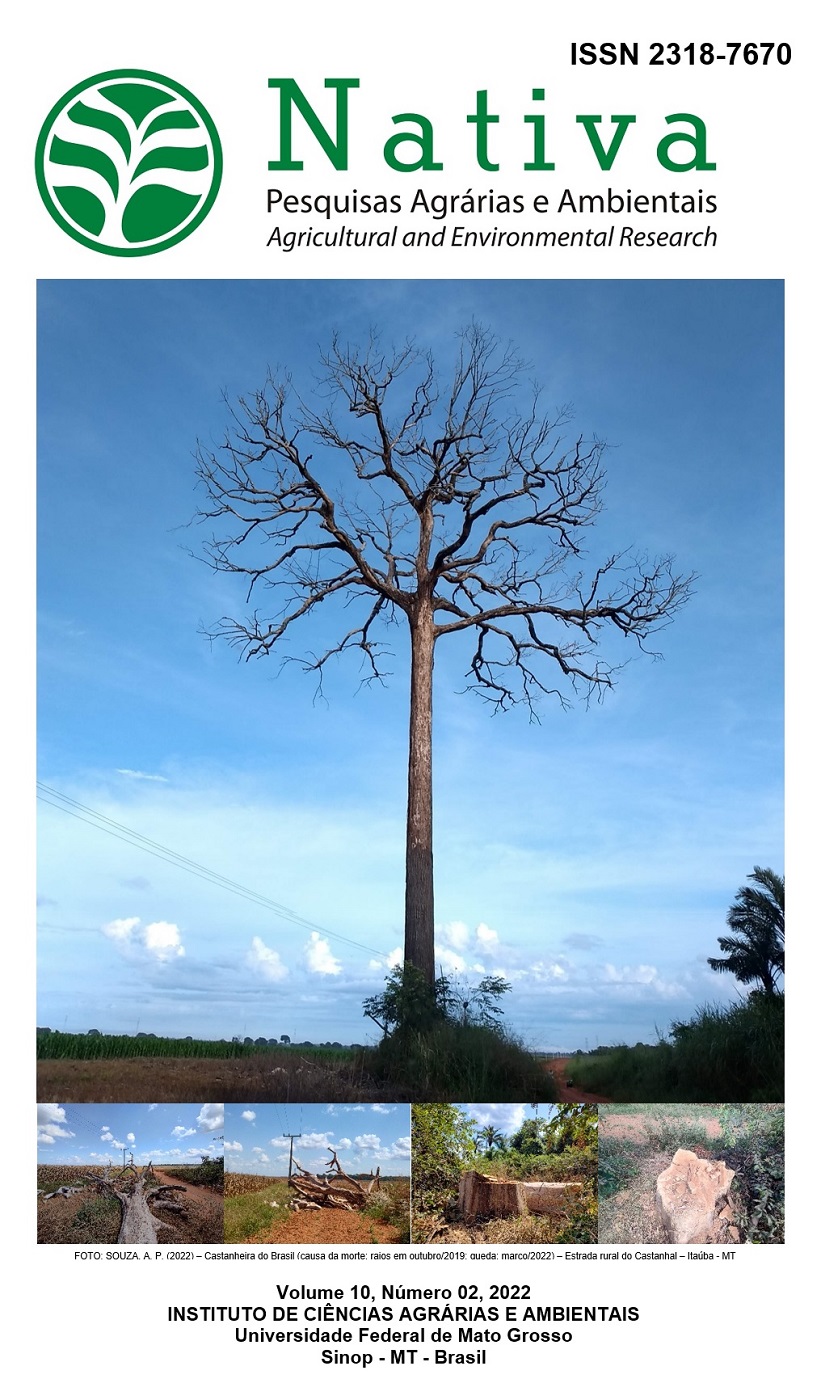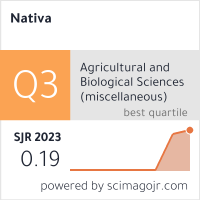THE USE OF BIOCHAR-UREA PELLET FORMULATIONS TO REDUCED NITROGEN LOSSES
DOI:
https://doi.org/10.31413/nativa.v10i2.13529Palavras-chave:
organomineral fertilizers, wood sawdust, pyrolysis, N-leachingResumo
This study aimed to evaluate the effects of soil texture, fertilizer formulation and nitrogen dose on the characteristics of upland rice production, and to compare the Agronomic Efficiency Index (AEI) of formulations of biochar-urea pellets (BUPs). The treatments comprised four fertilizers (three formulations of BUP and urea) and five nitrogen doses (0, 75, 150, 300 and 600 mg dm-3), analyzed in two soil (sandy and clay). For each soil texture, a greenhouse experiment was established as a randomized block design with a 5 x 4 factorial arrangement and four replicates. Chlorophyll index, plant height, number of tillers and panicles, dry mass of aerial parts and of grains were all affected significantly by soil texture, fertilizer formulation and nitrogen dose and/or by the interactions between these sources of variation. The results demonstrated that the performances of BUPs are highly dependent on soil texture. Under sandy soil, application of BUP-based fertilizers contributed to the increase or maintenance of grain production compared to that of urea alone. Whereas under clayey soil the performance of BUPs exceeded that of urea only at low nitrogen doses. Compared to urea, BUPs were more efficient under sandy soil, with potential to increase AEI.
KEYWORDS: organomineral fertilizers; wood sawdust; pyrolysis; N-leaching.
Uso de pellets de biochar-ureia para reduzir as perdas de nitrogênio
RESUMO: Este trabalho objetivou avaliar os efeitos da textura do solo, formulações e doses de nitrogênio em características do arroz de terras altas, e comparar o Índice de Eficiência Agronômica (AEI) das formulações de pellets de biochar-ureia (BUP’s). Os tratamentos foram: quatro fertilizantes (três formulações de BUP e ureia) e cinco doses de nitrogênio (0, 75, 150, 300 and 600 mg dm-3), avaliados em dois solos de textura distinta. Para cada solo (arenoso e argiloso), foi conduzido um experimento em casa-de-vegetação em blocos casualizados em um arranjo fatorial 5 (doses) x 4 (fertilizantes), com quatro repetições. O índice de clorofila, altura de plantas, número de perfilhos, número de panículas, massa seca de parte aérea, massa seca de grãos tiveram diferenças significativas em função da textura do solo, fertilizantes e doses de N e/ou pelas interações entre esses fatores. Os resultados demonstraram que o desempenho dos BUP’s foi dependente da textura do solo, com melhores respostas no solo arenoso em relação à ureia, com potencial de elevar a eficiência agronômica da adubação nitrogenada.
PALAVRAS-CHAVE: fertilizantes organominerais, pó de serra, pirólise, lixiviação de N.
Referências
AGEGNEHU, G.; NELSON, P. N.; BIRD, M. I. The effects of biochar, compost and their mixture and nitrogen fertilizer on yield and nitrogen use efficiency of barley grown on a Nitisol in the highlands of Ethiopia. Science of the Total Environment, v. 569-570, p. 869-879, 2016. DOI: 10.1016/j.scitotenv.2016.05.033
BAKI, J. M.; ABEDI-KOUPAI. Preparation and characterization of a superabsorbent slow-release fertilizer with sodium alginate and biochar. Journal of Applied Polymer Science, v. 135, n. 10, e45966, 2018. DOI: 10.1002/app.45966
CANTARELLA, H. Nitrogênio. In: NOVAIS, R. F.; ALVAREZ, V. H.; BARROS, N. F.; FONTES R. L. F.; CANTARUTTI, R. B.; NEVES, J. C. L. Fertilidade do solo. SBCS, 2007, p. 375-470.
DALL’ORSOLETTA, D. J.; RAUBER, L. P.; SCHMITT, D. E.; GATIBONI, L. C.; ORSOLIN, J. Urea coated with poultry litter as an option in the control of nitrogen losses. Revista Brasileira de Engenharia Agrícola e Ambiental, v. 21, n. 6, p. 398-403, 2017. DOI: 10.1590/1807-1929/agriambi.v21n6p398-403
ERNANI, P. R.; SANGOI, L.; RAMPAZZO, C. Lixiviação e imobilização de nitrogênio num Nitossolo como variáveis da forma de Aplicação da uréia e da palha de aveia. Revista Brasileira de Ciência do Solo, v. 26, n. 4, p. 993-1000, 2002. DOI: 10.1590/S0100-06832002000400017
FAGERIA, N. K.; BALIGAR, V.C. Enhancing nitrogen use efficiency in crop plants. Advances in Agronomy, v. 88, p. 97-185, 2005. DOI: 10.1016/S0065-2113(05)88004-6
FAWZY, S.; OSMAN, A. I.; YANG, H.; DORAN, J.; ROONEY, D. W. Industrial biochar systems for atmospheric carbon removal: a review. Environmental Chemistry Letters, v. 19, p. 3023-3055, 2021. DOI: 10.1007/s10311-021-01210-1
FERREIRA, D. F. Sisvar: a computer statistical analysis system. Ciência e Agrotecnologia, v. 35, n. 6, p. 1039-1042, 2011. DOI: 10.1590/S1413-70542011000600001
FEY, R.; ZOZ, T.; STEINER, F.; RICHART, A.; BRITO, O. R. Leaching of nitrogen in column in regarding soil particle size. Scientia Agraria, v. 11, p. 181-185, 2010.
FRAZÃO, J.; SILVA, A. R.; SILVA, V. L.; OLIVEIRA, V. A.; CORRÊA, R. S. Fertilizantes nitrogenados de eficiência aumentada e ureia na cultura do milho. Revista Brasileira de Engenharia Agrícola e Ambiental, v. 18, n. 12, p. 1262-1267, 2014. DOI: 10.1590/1807-1929/agriambi.v18n12p1262-1267
GUELFI, D. Fertilizantes nitrogenados estabilizados, de liberação lenta ou controlada. Informações Agronômicas, v. 157, p. 1-14, 2017.
INTERNATIONAL PLANT NUTRITION INSTITUTE - (IPNI). Nutrient Source Specifics: urea. 2019. Available from <http://www.ipni.net/publication/nss.nsf/0/5FE74632D6D80872852579AF00706626/$FILE/NSS-01%20Urea>.pdf. Epub 31 Jan 2022.
JIA, Y.; HU, Z.; BA, Y.; WENFANG, QI. Application of biochar-coated urea controlled loss of fertilizer nitrogen and increased nitrogen use efficiency. Chemical and Biological Technologies in Agriculture, v. 8, n. 3, p. 1-11, 2021. DOI: 10.1186/s40538-020-00205-4
KLUTHCOUSKI, J.; AIDAR, H.; THUNG, M.; OLIVEIRA, F. R. A.; COBUCCI, T. Manejo antecipado do nitrogênio nas principais culturas anuais. Embrapa Arroz e Feijão, 2006. 63p.
LEHMANN, J.; JOSEPH, S. Biochar for environmental management: an introduction. In: LEHMANN, J.; JOSEPH, S. (Eds.). Biochar for environmental management: science and technology. London: Earthscan, 2009. p. 1-9.
LENG, L.; HUANG, H. An overview of the effect of pyrolysis process parameters on biochar stability. Bioresource Technology, v. 270, p. 627-642, 2018. DOI: 10.1016/j.biortech.2018.09.030
MANIKANDAN, A.; SUBRAMANIAN, K. S. Urea intercalated biochar – a slow-release fertilizer production and characterization. Indian Journal of Science and Technology, v. 6, p. 1-6, 2013. DOI: 10.17485/ijst/2013/v6i12.11.
PETTER, F. A.; LIMA, L. B.; MARIMON JÚNIOR, B. H.; MORAIS, L. A.; MARIMON, B. S. Impact of biochar on nitrous oxide emissions from upland rice. Journal of Environmental Management, v. 169, p. 27-33, 2016. DOI: 10.1016/j.jenvman.2015.12.020
QUEIROZ, M. C. A. Eficiência agronômica de fertilizantes nitrogenados formulados a partir de biocarvão e fonte mineral. 88f. Dissertação (Mestrado) Agricultura Tropical e Subtropical - Instituto Agronômico, 2018.
RECH, I.; POLIDORO, J. C.; PAVINATO, P. S. Additives incorporated into urea to reduce nitrogen losses after application to the soil. Pesquisa Agropecuária Brasileira, v. 52, n. 3, p. 194-204, 2017. DOI: 10.1590/S0100-204X2017000300007
REETZ, H. F. Fertilizantes e o seu uso eficiente. São Paulo: ANDA, 2017. 178p.
SANGOI, L.; ERNANI, P. R.; LECH, V. A.; RAMPAZZO, C. Lixiviação de nitrogênio afetada pela forma de aplicação da uréia e manejo dos restos culturais de aveia em dois solos com texturas contrastantes. Ciência Rural, v. 33, n. 1, p. 65-70, 2003. DOI: 10.1590/S0103-84782003000100010
SHI, W.; JU, Y.; BIAN, R.; LI, L.; JOSEPH, S.; MITCHELL, D. R. G.; MUNROE, P.; TAHERYMOOSAVI, S.; PAN, G. Biochar bound urea boosts plant growth and reduces nitrogen leaching. Science of the Total Environment, v. 701, e134424, 2020. DOI: 10.1016/j.scitotenv.2019.134424
TIMILSENA, Y. P.; ADHIKARI, R.; CASEY, P.; MUSTER, T.; GILL, H.; ADHIKARI, B. Enhanced efficiency fertilisers: a review of formulation and nutrient release patterns. Journal of Science Food Agriculture, v. 95, n. 6, p. 1131-1142, 2015. DOI: 10.1002/jsfa.6812
ZHENG, H.; WANG, Z.; DENG, X.; HERBERT, S.; XING, B. Impacts of adding biochar on nitrogen retention and bioavailability in agricultural soil. Geoderma, v. 206, n. 1, p. 32-39, 2013. DOI: 10.1016/j.geoderma.2013.04.018
Downloads
Publicado
Versões
- 2023-10-06 (2)
- 2022-06-03 (1)
Edição
Seção
Como Citar
Licença
Copyright (c) 2022 Nativa

Este trabalho está licenciado sob uma licença Creative Commons Attribution-NonCommercial 4.0 International License.
Direitos Autorais para artigos publicados nesta revista são do autor, com direitos de primeira publicação para a revista. Em virtude de a aparecerem nesta revista de acesso público, os artigos são de uso gratuito, com atribuições próprias, em aplicações educacionais e não-comerciais.
A artigos publicados nessa revista, podem ser reproduzidos parcialmente ou utilizados como referência por outros autores, desde que seja cita a fonte, ou seja, a Revista Nativa.
Copyright for articles published in this journal are the authors, with first publication rights granted to the journal. The journal shows open access, and articles are free to use, with proper attribution, in educational and non-commercial.
The articles published in this journal may be reproduced in part or used as a reference by other authors, provided that the source is quoted.






